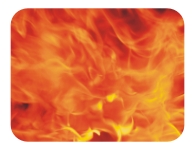|
 The potential for an explosion with either LPG (LP Gas) or petrol vapour should not be underestimated. Both form highly explosive and easily ignitable mixtures with air. Being heavier than air, both LPG and the vapour from petrol will sink to the lowest point. In a boat this often below deck (eg bilge) where it will collect with no way of escaping The potential for an explosion with either LPG (LP Gas) or petrol vapour should not be underestimated. Both form highly explosive and easily ignitable mixtures with air. Being heavier than air, both LPG and the vapour from petrol will sink to the lowest point. In a boat this often below deck (eg bilge) where it will collect with no way of escaping
Explosions
An explosion occurs when a flammable gas or vapour is allowed to build up and is then ignited. During an explosion the combustible zone propagates rapidly through the entire mixture and the energy released causes a high energy shock wave. It is this shock wave that can cause enormous damage and endanger life. For an explosion to occur 3 elements need to come together - a flammable gas, air and a source of ignition.
Flammable Range
Every flammable gas or vapour has a flammable range. At concentrations below this range the mixture is too ‘lean’ and will not ignite. At concentrations above this range the mixture is too ‘rich’ and also will not ignite. The concentrations at which this flammable zone start and stop are know as the Lower Explosive Limit (LEL) and the Upper Explosive Limit (UEL). Alternative names are the Lower Flammable Limit (LFL) and the Upper Flammable Limit (UFL). Limits for the gases and vapours found on boats are,
|
|
LEL/LFL
|
UEL/UFL
|
Ignition Temp
|
|
Butane (C4H10)
|
1.4% volume in air
|
9.3% volume in air
|
372 °C
|
|
Propane (C3H8)
|
1.7% volume in air
|
10.9% volume in air
|
470 °C
|
|
Petrol Vapour
|
1.2% volume in air
|
8.0% volume in air
|
560 °C
|
|
|
In practical situations, the above concentrations of gas can easily occur following a leak. Even though the gas concentration at the source of the leak may be above the UEL, it will quickly fall into the flammable range as the gas/vapour disperses and mixes with air. As both LPG and petrol vapour are heavier than air, the explosive mixture is all too often contained with in the hull of the boat with no way of escaping. This is obviously a disaster waiting to happen.
Ignition
The ignition source of an explosion can be a naked flame (eg pilot light), a spark (eg from an engine or electrical switch) or a hot surface above the ignition temperature of the gas/vapour (eg engine exhaust manifold). Once the source of ignition has started the reaction, the heat generated is sufficient to sustain the reaction throughout the entire mixture resulting in an explosion.
<<< back to Information
|

